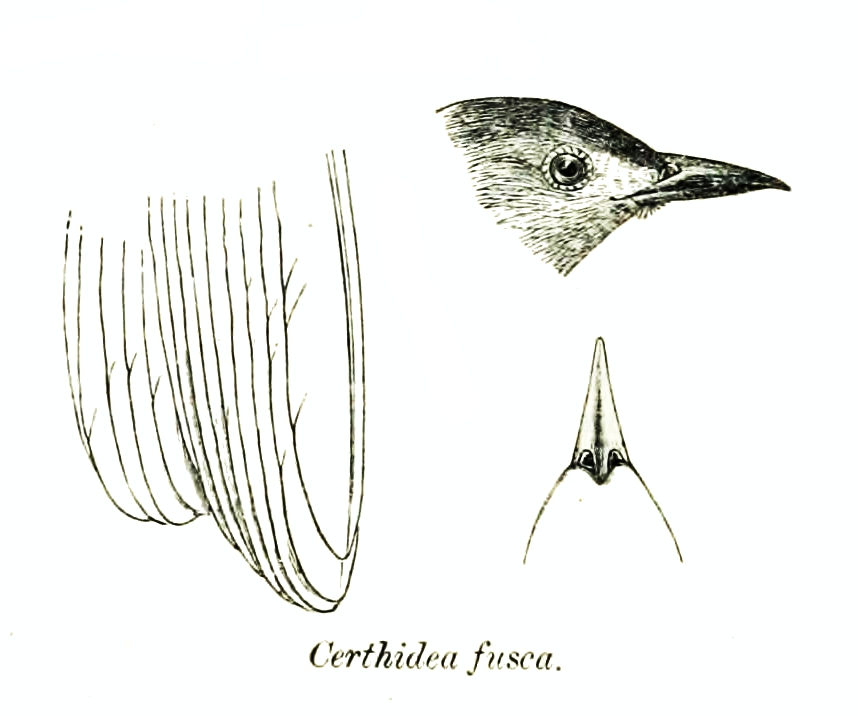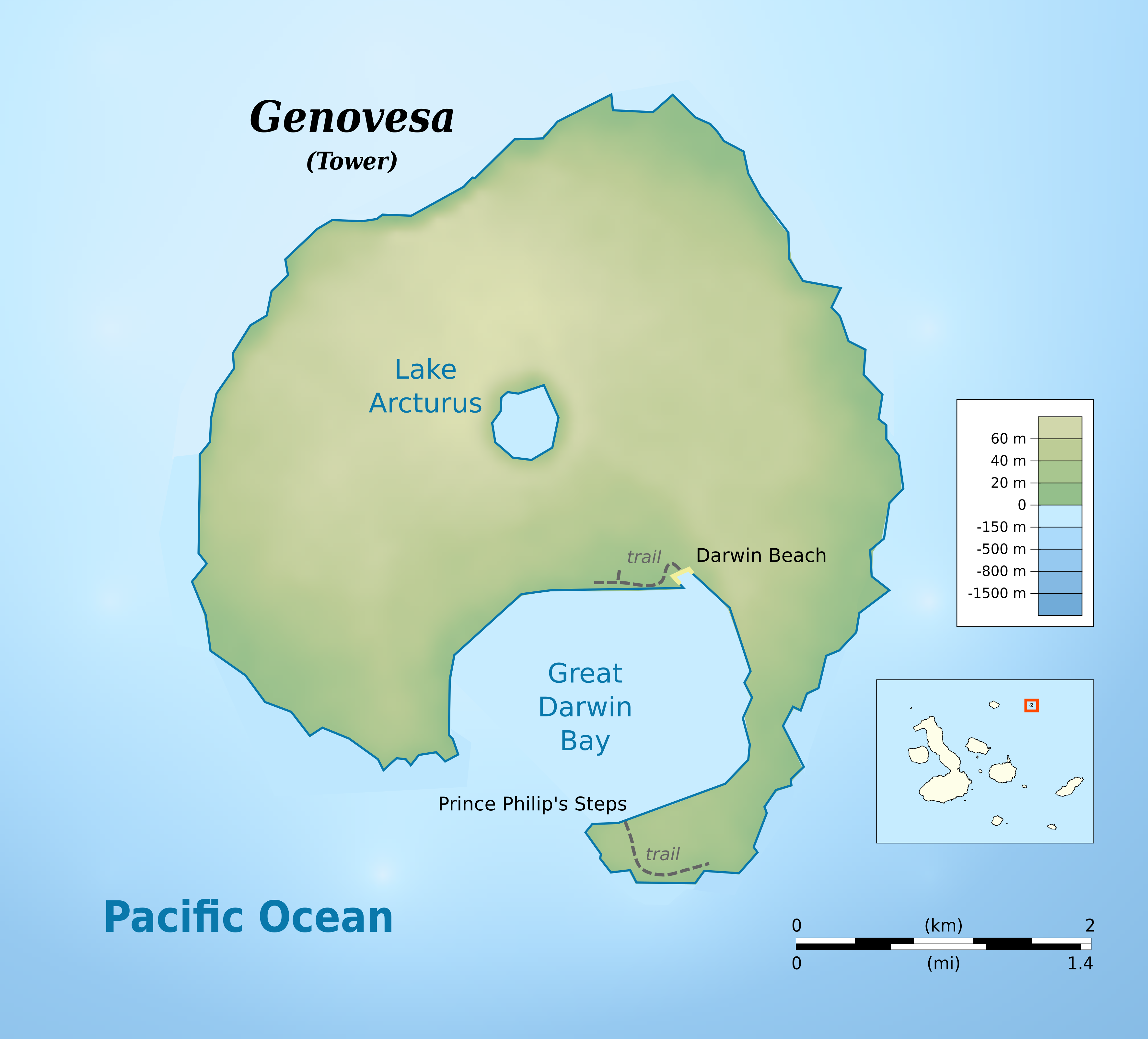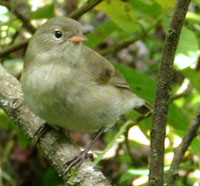|
Grey Warbler-finch
The grey warbler-finch (''Certhidea fusca'') is a species of bird, one of Darwin's finches in the tanager family Thraupidae. Sometimes classified in the family Emberizidae, more recent studies have shown it to belong in the tanager family. It is endemic to the Galápagos Islands, Ecuador. This species is closely related to the green warbler-finch, and were formerly considered conspecific, but both species differed in appearance, distribution, habitat, and song. The nominate subspecies is from Pinta and Marchena, ''becki'' from Darwin and Wolf, ''mentalis'' from Genovesa, ''bifasciata'' from Santa Fé, ''cinerascens'' from Española, ''luteola'' from San Cristóbal, and ''ridgwayi'' from Floreana. Grey warbler-finches are found mostly in the shrubland and dry forest of smaller drier islands, and have a suitable coloration for their habitat. Its natural habitats are subtropical or tropical dry forests, subtropical or tropical moist montane forests, and subtropical or tropic ... [...More Info...] [...Related Items...] OR: [Wikipedia] [Google] [Baidu] |
Philip Sclater
Philip Lutley Sclater (4 November 1829 – 27 June 1913) was an England, English lawyer and zoologist. In zoology, he was an expert ornithologist, and identified the main zoogeographic regions of the world. He was Secretary of the Zoological Society of London for 42 years, from 1860–1902. Early life Sclater was born at Tangier Park, in Wootton St Lawrence, Hampshire, where his father William Lutley Sclater had a country house. George Sclater-Booth, 1st Baron Basing was Philip's elder brother. Philip grew up at Hoddington House where he took an early interest in birds. He was educated in school at Twyford and at thirteen went to Winchester College and later Corpus Christi College, Oxford where he studied scientific ornithology under Hugh Edwin Strickland. In 1851 he began to study law and was admitted a Fellow of Corpus Christi College. In 1856 he travelled to America and visited Lake Superior and the upper St. Croix River (Wisconsin–Minnesota), St. Croix River, cano ... [...More Info...] [...Related Items...] OR: [Wikipedia] [Google] [Baidu] |
Genovesa
Genovesa Island (Spanish: ''Isla Genovesa''), referred to in English as Tower Island, is a shield volcano in the Galápagos Islands in the eastern Pacific Ocean. The island occupies about , and its maximum elevation is . The horse-shoe shaped island has a volcanic caldera whose wall has collapsed, forming the Great Darwin Bay, surrounded by cliffs. Lake Arcturus, filled with salt water, lies in the centre, and sediment within this crater lake is less than 6,000 years old. Although no historical eruptions are known from Genovesa, there are very young lava flows on the flanks of the volcano. The official Spanish name "Genovesa" is from the Italian city of Genoa, in honor of Christopher Columbus. The English name "Tower" is presumably a corruption of "Downes". The island's position was reported by John Downes of the USS ''Essex'' in 1813, during the War of 1812, and the name "Dowers's" appeared in 1815, presumably a misspelled reference to Downes. After passing through "Dow ... [...More Info...] [...Related Items...] OR: [Wikipedia] [Google] [Baidu] |
Taxa Named By Philip Sclater
In biology, a taxon (back-formation from ''taxonomy''; plural taxa) is a group of one or more populations of an organism or organisms seen by taxonomists to form a unit. Although neither is required, a taxon is usually known by a particular name and given a particular ranking, especially if and when it is accepted or becomes established. It is very common, however, for taxonomists to remain at odds over what belongs to a taxon and the criteria used for inclusion. If a taxon is given a formal scientific name, its use is then governed by one of the nomenclature codes specifying which scientific name is correct for a particular grouping. Initial attempts at classifying and ordering organisms (plants and animals) were set forth in Carl Linnaeus's system in ''Systema Naturae'', 10th edition (1758), as well as an unpublished work by Bernard and Antoine Laurent de Jussieu. The idea of a unit-based system of biological classification was first made widely available in 1805 in the intro ... [...More Info...] [...Related Items...] OR: [Wikipedia] [Google] [Baidu] |
Birds Described In 1870
Birds are a group of warm-blooded vertebrates constituting the class Aves (), characterised by feathers, toothless beaked jaws, the laying of hard-shelled eggs, a high metabolic rate, a four-chambered heart, and a strong yet lightweight skeleton. Birds live worldwide and range in size from the bee hummingbird to the ostrich. There are about ten thousand living species, more than half of which are passerine, or "perching" birds. Birds have whose development varies according to species; the only known groups without wings are the extinct moa and elephant birds. Wings, which are modified forelimbs, gave birds the ability to fly, although further evolution has led to the loss of flight in some birds, including ratites, penguins, and diverse endemic island species. The digestive and respiratory systems of birds are also uniquely adapted for flight. Some bird species of aquatic environments, particularly seabirds and some waterbirds, have further evolved for swimming. ... [...More Info...] [...Related Items...] OR: [Wikipedia] [Google] [Baidu] |
Endemic Birds Of The Galápagos Islands
Endemism is the state of a species being found in a single defined geographic location, such as an island, state, nation, country or other defined zone; organisms that are indigenous to a place are not endemic to it if they are also found elsewhere. For example, the Cape sugarbird is found exclusively in southwestern South Africa and is therefore said to be ''endemic'' to that particular part of the world. An endemic species can be also be referred to as an ''endemism'' or in scientific literature as an ''endemite''. For example '' Cytisus aeolicus'' is an endemite of the Italian flora. '' Adzharia renschi'' was once believed to be an endemite of the Caucasus, but it was later discovered to be a non-indigenous species from South America belonging to a different genus. The extreme opposite of an endemic species is one with a cosmopolitan distribution, having a global or widespread range. A rare alternative term for a species that is endemic is "precinctive", which applies to s ... [...More Info...] [...Related Items...] OR: [Wikipedia] [Google] [Baidu] |
Certhidea
The warbler-finches are a genus ''Certhidea'' of birds in the tanager family Thraupidae that are endemic to the Galápagos Islands. Together with related genera, they are collectively known as Darwin's finches. The two species were formerly considered to be conspecific; however, they have different songs, prefer different habitats, and are located in different areas on the islands. Taxonomy and species list The genus ''Certhidea'' was introduced in 1837 by the English ornithologist John Gould with the green warbler-finch as the type species. The name is a Latin diminutive of the genus ''Certhia'' introduced by Carl Linnaeus in 1758 for the treecreepers. The members of the genus form part of a group collectively known as Darwin's finches. Although traditionally placed with the buntings and New World sparrows in the family Emberizidae, molecular phylogenetic studies have shown that Darwin's finches are members of the subfamily Coerebinae within the tanager family Thraupidae Th ... [...More Info...] [...Related Items...] OR: [Wikipedia] [Google] [Baidu] |
Shrubland
Shrubland, scrubland, scrub, brush, or bush is a plant community characterized by vegetation dominated by shrubs, often also including grasses, herbs, and geophytes. Shrubland may either occur naturally or be the result of human activity. It may be the mature vegetation type in a particular region and remain stable over time, or a transitional community that occurs temporarily as the result of a disturbance, such as fire. A stable state may be maintained by regular natural disturbance such as fire or browsing. Shrubland may be unsuitable for human habitation because of the danger of fire. The term was coined in 1903. Shrubland species generally show a wide range of adaptations to fire, such as heavy seed production, lignotubers, and fire-induced germination. Botanical structural form In botany and ecology a shrub is defined as a much-branched woody plant less than 8 m high and usually with many stems. Tall shrubs are mostly 2–8 m high, small shrubs 1–2 m high and su ... [...More Info...] [...Related Items...] OR: [Wikipedia] [Google] [Baidu] |
Tropical
The tropics are the regions of Earth surrounding the Equator. They are defined in latitude by the Tropic of Cancer in the Northern Hemisphere at N and the Tropic of Capricorn in the Southern Hemisphere at S. The tropics are also referred to as the tropical zone and the torrid zone (see geographical zone). In terms of climate, the tropics receive sunlight that is more direct than the rest of Earth and are generally hotter and wetter as they aren't affected as much by the solar seasons. The word "tropical" sometimes refers to this sort of climate in the zone rather than to the geographical zone itself. The tropical zone includes deserts and snow-capped mountains, which are not tropical in the climatic sense. The tropics are distinguished from the other climatic and biomatic regions of Earth, which are the middle latitudes and the polar regions on either side of the equatorial zone. The tropics constitute 40% of Earth's surface area and contain 36% of Earth's landmass. , the ... [...More Info...] [...Related Items...] OR: [Wikipedia] [Google] [Baidu] |
Montane Forest
Montane ecosystems are found on the slopes of mountains. The alpine climate in these regions strongly affects the ecosystem because temperatures fall as elevation increases, causing the ecosystem to stratify. This stratification is a crucial factor in shaping plant community, biodiversity, metabolic processes and ecosystem dynamics for montane ecosystems. Dense montane forests are common at moderate elevations, due to moderate temperatures and high rainfall. At higher elevations, the climate is harsher, with lower temperatures and higher winds, preventing the growth of trees and causing the plant community to transition to montane grasslands, shrublands or alpine tundra. Due to the unique climate conditions of montane ecosystems, they contain increased numbers of endemic species. Montane ecosystems also exhibit variation in ecosystem services, which include carbon storage and water supply. Life zones As elevation increases, the climate becomes cooler, due to a decrease in a ... [...More Info...] [...Related Items...] OR: [Wikipedia] [Google] [Baidu] |
Forest
A forest is an area of land dominated by trees. Hundreds of definitions of forest are used throughout the world, incorporating factors such as tree density, tree height, land use, legal standing, and ecological function. The United Nations' Food and Agriculture Organization (FAO) defines a forest as, "Land spanning more than 0.5 hectares with trees higher than 5 meters and a canopy cover of more than 10 percent, or trees able to reach these thresholds ''in situ''. It does not include land that is predominantly under agricultural or urban use." Using this definition, '' Global Forest Resources Assessment 2020'' (FRA 2020) found that forests covered , or approximately 31 percent of the world's land area in 2020. Forests are the predominant terrestrial ecosystem of Earth, and are found around the globe. More than half of the world's forests are found in only five countries (Brazil, Canada, China, Russia, and the United States). The largest share of forests (45 percent) are in th ... [...More Info...] [...Related Items...] OR: [Wikipedia] [Google] [Baidu] |
Subtropical
The subtropical zones or subtropics are geographical zone, geographical and Köppen climate classification, climate zones to the Northern Hemisphere, north and Southern Hemisphere, south of the tropics. Geographically part of the Geographical zone#Temperate zones, temperate zones of both hemispheres, they cover the middle latitudes from to approximately 35° north and south. The horse latitudes lie within this range. Subtropical climates are often characterized by hot summers and mild winters with infrequent frost. Most subtropical climates fall into two basic types: humid subtropical climate, humid subtropical (Köppen climate classification, Koppen climate Cfa), where rainfall is often concentrated in the warmest months, for example list of regions of China, Southeast China and the Southeastern United States, and Mediterranean climate, dry summer or Mediterranean climate (Köppen climate classification, Koppen climate Csa/Csb), where seasonal rainfall is concentrated in the c ... [...More Info...] [...Related Items...] OR: [Wikipedia] [Google] [Baidu] |
Floreana
Floreana Island (Spanish: ''Isla Floreana'') is an island of the Galápagos Islands. It was named after Juan José Flores, the first president of Ecuador, during whose administration the government of Ecuador took possession of the archipelago. It was previously called Charles Island (after King Charles II of England), and Santa María after one of the caravels of Columbus. The island has an area of . It was formed by volcanic eruption. The island's highest point is Cerro Pajas at , which is also the highest point of the volcano like most of the smaller islands of Galápagos. History Since the 19th century, whalers kept a wooden barrel at Post Office Bay, so that mail could be picked up and delivered to their destination by ships on their way home, mainly to Europe and the United States. Cards and letters are still placed in the barrel without any postage. Visitors sift through the letters and cards in order to deliver them by hand. Due to its relatively flat surface, supp ... [...More Info...] [...Related Items...] OR: [Wikipedia] [Google] [Baidu] |



.jpg)
.jpg)




